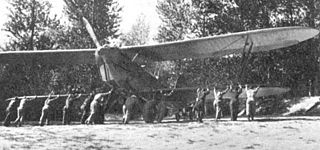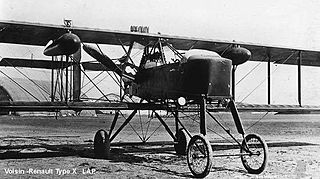Related Research Articles

The Aero A.101 was a biplane light bomber and reconnaissance aircraft built in Czechoslovakia during the 1930s.

The Voisin III was a French World War I two-seat pusher biplane multi-purpose aircraft developed by Voisin in 1914 as a more powerful version of the 1912 Voisin I. It is notable for being the aircraft used for the first successful shooting down of an enemy aircraft on October 5, 1914, and to have been used to equip the first dedicated bomber units, in September 1914.

The Salmson 2 A.2, was a French biplane reconnaissance aircraft developed and produced by Salmson to a 1916 requirement. Along with the Breguet 14, it was the main reconnaissance aircraft of the French army in 1918 and was also used by American Expeditionary Force aviation units. At the end of the First World War, one-third of French reconnaissance aircraft were Salmson 2s.

The Dorand AR.1 was a World War I French two-seat observation biplane aircraft used by the French Air Force, the American Expeditionary Force and, in small numbers, by Serbian Aviation.

The Caudron R.11, was a French three-seat twin-engine long range escort fighter biplane developed and produced by Caudron during the First World War.

The Hanriot H.43 was a military utility aircraft produced in France in the late 1920s and early 1930s which was primarily used by the Aéronautique Militaire as a trainer. While Hanriot had spent most of the 1920s manufacturing further and further developments of the HD.14 that had flown in 1920, the H.43 was an entirely new design. It was a conventional single-bay biplane with staggered wings of unequal span and a fuselage of fabric-covered metal tube. Accommodation for the pilot and passenger was in tandem, open cockpits and the main units of the fixed, tailskid undercarriage were linked by a cross-axle.

The Salmson-Moineau S.M.1 A3,, was a French armed three-seat biplane long range reconnaissance aircraft of the First World War designed by René Moineau for the Salmson company.

The Potez 32 and its military version the Potez 33 was a single-engine French monoplane transport built by Potez and based on the Potez 29 biplane.

The Letord Let.5 was probably the most numerous of a family of 3-seat reconnaissance bombers, designed and built in France from 1916, originally to an A3 specification from the STAé.
The Adolphe Bernard AB was a twin-engined French biplane aircraft, built near the end of the First World War. Ten AB 1 BN2 bombers were produced for the Armée de l'Air but did not reach squadron service; post-war, two civil derivatives were considered but only one aircraft was built.
The Voisin VI or Voisin Type 6 was a French pusher biplane bomber aircraft of World War I.
The Salmson 5 was a French aircraft built in 1917 during World War I intended for artillery spotting. It was based on the Salmson 2, but it was 23 km/h slower and offered no compensating advantages and only 1 aircraft was built.

The Caudron C.23 was a French long range twin engine night bomber, flown in the last year of World War I. Post-war some machines were modified to carry passengers.

The Nieuport 15 was a French World War I bomber aircraft. Due to disappointing performance the type was rejected and never entered service.
The Blériot 73 was a large First World War French heavy night bomber designed and built by Blériot to the BN3 specification. Only a single prototype was built, which crashed on landing from its first flight, killing the pilot. The Blériot 74, Blériot 75 and Blériot 76, respectively, a heavy bomber / airliner, airliner and heavy bomber, directly evolved mfrom the Blériot 71 / Blériot 73 bombers.

The Voisin X was a French two-seat pusher biplane which was built in two versions, one fitted with a 37 mm (1.46 in) Hotchkiss cannon, and the other as a conventional night bomber. Problems with the Peugeot engine in the previous Voisin VIII led to the installation of a new Renault engine of greater power and reliability, but the new aircraft was otherwise nearly identical to the VIII. Despite its obsolescence, it would make up the bulk of front line night bomber escadrilles until the end of the war.

The Voisin XII was a prototype French two-seat four-engine biplane bomber built near the end of the First World War but which did not enter service.

The Voisin IV was a French two-seat bomber and ground attack aircraft of World War I.

The Voisin VII was a French reconnaissance pusher biplane aircraft of World War I.
The Salmson 3 C.1 was a French World War I biplane fighter aircraft developed by Salmson which lost out in competition to the SPAD XIII and Morane-Saulnier AI.
References
Notes
Citations
Bibliography
- Davilla, Dr. James J.; Soltan, Arthur (1997). French Aircraft of the First World War. Mountain View, CA: Flying Machines Press. pp. 447–448. ISBN 978-1891268090.
- Grey, C.G. (1969). Jane's All the World's Aircraft 1919 (Facsimile ed.). London: David & Charles (Publishers) Limited. ISBN 0-7153-4647-4.
- Parmentier, Bruno. "Salmson SAL-4". aviafrance.com (in French). Retrieved 12 June 2014.